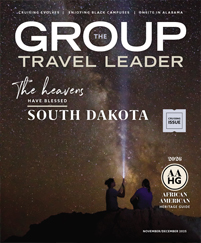Native American groups all over the U.S. continue to practice and share with others the crafts of their ancestors, like handweaving baskets and sculpting figurines out of wood. Here are five regions your group can explore to watch Native artists at work, learn more about their tribes’ histories and shop their exquisite creations.
Gallup
New Mexico
Gallup, New Mexico, is an excellent place to find, enjoy and purchase beautiful, handcrafted pieces of Native art.
One must-visit business is Tanner’s Indian Arts on Coal Avenue. By appointment only, the Southwest Indian art company serves as an art gallery and museum as well as a shop. It offers all-natural, gem-quality turquoise and Native American jewelry, rugs and pottery. Joe Tanner runs the shop, along with his wife, Cynthia, and daughter, Emerald.
“Emerald is a great resource,” said Teri Fraizer director of the Gallup Cultural Center. “She was raised in our community. When you walk in Joe Tanner’s store, everything is antique.”
Another good place to find carefully crafted works of art is the Perry Null Trading Post. Here, guests are wowed by the colorful handmade jewelry and artwork made by multiple Native American tribes. Each piece is carefully crafted and said to have its own story, be it of the artist or the history of the work itself.
“We’re an authentic trading post,” said Perry Null, owner of the trading company. “We deal directly with the Native Americans — the Navajos, the Zunis, the Hopis, Acomas, Laguna. They bring their arts and crafts to us, and we buy them and represent them in this area. All our things are authentic and handmade items.”
Chickasaw Country
Oklahoma
A variety of artwork representing the Chickasaw people, a tribe originally based in northeastern Mississippi and known for being excellent warriors and hunters, can be found at the Chickasaw Cultural Center in Sulphur, Oklahoma. Within its 184-acre campus is the Aaittafama’ Room, a space that provides rotating art collections, and the Aapisa’ Art Gallery, which showcases changing exhibits by different Chickasaw artists. The center usually works with one or two artists every three or four months. For guests who want to soak in even more information, artists often give live demonstrations in the gallery.
“Each artist will hold a live demo, and patrons can come listen and watch or ask questions,” said Joanna John, senior collections manager for the Chickasaw Cultural Center. “We have had mostly hands-on demos, so that’s been really interesting, and we sell the art in the exhibit or out of the exhibit.”
Other creative pieces, including sculptures, can be seen all over the campus. One must-view statue is The Arrival, which shows a Chickasaw group that recently arrived to its new territory in Oklahoma after being removed from its land. It’s a piece that is meant to show hope and resilience.
“We want people to be immersed in the culture, so you walk on the campus, and these symbols are all around you in the architecture, in the water features, in the sculptures,” John said. “You don’t really notice it until you start learning about them, and then you see that it’s really all around you.”
ARTesian Gallery and Studios in Sulphur is another fantastic place to explore the Chickasaw culture. Visitors are encouraged to check out its retail shop, where they can find jewelry, books and other items created by Chickasaw and First American artists.
Plus, the Chickasaw Nation Welcome Center in Davis houses a gallery that features a different Native artist’s work each quarter. These visual works often tell stories of the artists, as well as celebrate their heritage.
Anchorage
Alaska
Beautiful, distinct Alaskan art can be found and discussed in many pockets of Anchorage.
Guests can explore 10,000 years of Alaska’s past at the Alaska Native Heritage Center by listening to stories, walking through authentic Native dwellings and watching films. Its Hall of Cultures is designed to represent all the Alaska Native cultural groups; exhibits shine a light on each group’s history and feature traditional art and regalia.
The center is a wonderful place to visit throughout the year, but the summer brings the chance to interact with artists representing different Native groups in booths they set up throughout the facility.
“We’re a living cultural center,” said Nikki Graham, the center’s director of operations. “We have dance groups, we have Native game demonstrations and different cultural classes, and we have artists — it’s almost like a marketplace during the summer. You hear drumming and music, and it’s just alive.”
Guests also have the chance to browse the center’s Ch’k’iqadi Gallery, a unique gift shop that focuses solely on selling Alaska Native art.
“It’s not a standard gift shop, so it doesn’t have a lot of the tourist fare,” said Cika Sparck, the gallery’s manager. “We make sure that everything [from jewelry and kitchenware to high-end art] is tied to Indigenous arts.”
The Anchorage Museum, located downtown, is another great place to visit. Home to a slew of permanent and traveling exhibits, it also houses several collections that focus on Alaska and the Circumpolar North. Its art collection, in particular, is made up of visual works by Alaskan artists and contemporary Alaska Native art. Various animal figurines and a walrus ivory cribbage board are examples of pieces guests might see. The museum’s store also houses Alaska Native art that’s available for purchase.
Cherokee
North Carolina
The lifestyle, history and culture of the Eastern Band of Cherokee Indians can be seen and felt in Cherokee, North Carolina. This tribe is notorious for creating art out of nature, such as intricate baskets carefully woven out of rivercane and sculptures and ladles carved out of wood. These items and more can be found at Qualla Arts and Crafts Mutual, which was established in 1946 by Cherokee craftspeople and leaders who were trying to strengthen tribal values by preserving and promoting their crafts. Guests are sure to find pieces they love from the vast selection of handcrafted items made by Qualla’s more than 300 artist members.
“When you walk into our store, it kind of takes your breath with the beauty of the baskets and the way the store is set up,” said Vicki Cruz, director of Qualla Arts and Crafts Mutual. “We’ve got a timeline in our permanent collection gallery where it tells how we were established and what we are doing nowadays.”
History and art combine for an unforgettable experience at the Museum of the Cherokee Indian, where guests can explore 12,000 years’ worth of this group’s past. Life-size figures, art, artifacts and more are used to paint a picture of this tribe’s storied history. Although there is not a set schedule, most days, guests are able to interact with cultural specialists throughout the museum who are wearing traditional Cherokee dress and practicing crafts, such as finger weaving.
“They’re all so incredibly knowledgeable about history, about the craft — they’re all practicing artisans — so really getting that one-on-one, getting to see these pieces made in action and really hear the stories behind that is a really unique opportunity,” said Anna Chandler, manager of external affairs and communications for the Museum of the Cherokee Indian.
Rapid City
South Dakota
Traditional beadwork, painted drums and contemporary pieces by Native American artists are just a few of the creative works of art found in Rapid City, South Dakota.
Located downtown, the Prairie Edge Trading Company and Galleries takes guests on an experience, the ability to delve into Native culture. A variety of items, such as blankets and quilts, made by both Native and non-Native artists are available for purchase; Native American-made art, which can be found in the Prairie’s Fine Art Gallery, is also for sale. It is said that sounds of a Native music, like the Lakota flute, can be heard in the building.
“It’s a very immersive experience,” said Shelby Solano, destination manager for Visit Rapid City. “As soon as you walk in, they have different pieces by artisans all over the nation, as well as local to our region here. They try to support local artists, specifically from the Pine Ridge and Rosebud reservations.”
Guests can watch the “artistic magic” happen at Dakota Drum, where Lakota artist Sonja Holy Eagle can be seen creating and painting buffalo-hide drums. Her exquisite designs, along with items made by artists from the Cheyenne River, Pine Ridge, Standing Rock and Rosebud reservations, are available for purchase.
“[Sonja] is able to tell her story,” Solano said. “She’s able to tell the history behind the drums, the history behind her artwork, and she’s there to answer any questions of any patrons who come through the door and give them that experience.”
Art created by Lakota tribal members can also be found at the Tusweca Gallery in downtown Rapid City. Many of the pieces offer striking, colorful visuals of Native scenes and culture.
“They really home in on designs that inspire and nurture the spirit of the Oglala tradition and their local history,” Solano said.











